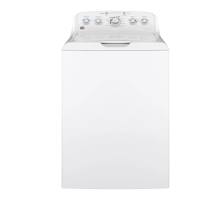What to do if detergent packets are not dissolving in my GE Washer?
- Nnathan78Sep 23, 2025
Laundry detergent packets should not be used in the dispensers. They should only be added directly to the wash basket following the manufacturer’s directions.

What to do if detergent packets are not dissolving in my GE Washer?
Laundry detergent packets should not be used in the dispensers. They should only be added directly to the wash basket following the manufacturer’s directions.
What to do if water is siphoning out of my GE GTW465?
If water is siphoning out of your GE washer, the drain hose must exceed 30” height at some point between the washer back and the drain pipe. Use an anti-siphon clip and refer to the Installation Instructions for proper setup.
Why are laundry additives dispensing too soon in my GE GTW465 Washer?
If you're experiencing laundry additives dispensing too soon in your GE Washer (on some models), avoid overfilling the dispensers or adding water to them. When using fabric softener, select the Deep Rinse/Extra Rinse option.
What to do if my GE GTW465 won’t drain?
If your GE Washer isn’t draining, make sure the drain hose isn't kinked or that the washer isn't sitting on it. The top of the drain outlet should be less than 8 ft (2.44 m) above the floor. Straighten the drain hose and ensure proper connection.
Why are my clothes too wet after washing in my GE GTW465 Washer?
If clothes are coming out of your GE Washer too wet, ensure that the cycle selected matches the load you are washing. Some fabrics will feel wetter when rinsed with cold water. If the wash load is out of balance, redistribute the load in the washer and run it through a Drain & Spin cycle.
Why does the agitator seem loose on my GE GTW465 Washer?
If the agitator seems loose on your GE Washer (on some models), it is designed to be flexible to allow for care of large bulky items such as comforters; this is normal.
How to fix a GE GTW465 Washer that won't operate?
If your GE Washer isn't operating, here are a few things to check: * Make sure the power cord is securely plugged into a working outlet. * Ensure both hot and cold water faucets are fully turned on. * Confirm that the lid is closed and press Start, as a safety feature prevents operation when the lid is open. * Check your house's circuit breakers or fuses and replace if necessary. The washer should ideally have its own separate outlet. * Try resetting the electronics by unplugging the washer, waiting two minutes, plugging it back in, and then pressing Start. * Ensure you have pressed the Start button.
How to fix a GE GTW465 Washer when the water won’t drain?
If the water isn't draining from your GE washer, check if the drain hose is kinked or improperly connected. Straighten the drain hose, ensure the washer isn't sitting on it, and verify that the top of the drain outlet is less than 8 ft (2.44 m) above the floor.
Why is my GE GTW465 leaking water?
If your GE Washer is leaking water, there are several things to check: * Switch to High Efficiency detergent. * Use less detergent, especially if you have soft water or are washing a small or lightly soiled load. * Ensure fill and drain hoses are tightly connected at the faucets with rubber washers installed, and the drain hose is correctly inserted and secured to the drain. * Check your household plumbing for clogs; you may need to call a plumber. * Ensure the drain hose isn't rubbing against the wall, which can cause wear. * Tighten the hoses at the faucets and inspect the fill hoses, replacing them every 5 years.
Why is there lint or residue on clothes after washing in my GE GTW465?
If your GE Washer is producing lint or residue on clothes, here's what might be happening: * Clothes that are air-dried or line-dried may retain more lint. * Ensure you are separating lint producers from lint collectors. * Avoid washing small loads for too long; use a Light Soil setting for shorter wash times. * Rewash, using a liquid detergent and warmer water temperature to help dissolve detergent. * Loosely load clothes in the washer basket, placing items around the outside for best results. * Check the fabric softener package for correct usage and ensure you've selected the Deep Rinse/Extra Rinse option (on some models).
| Appliance Category | Washer |
|---|---|
| Washer Type | Top Load |
| Capacity | 4.5 cu. ft. |
| Color | White |
| Maximum Spin Speed | 700 RPM |
| Energy Star Certified | Yes |
| Voltage | 120 V |
| Wash Cycles | Bulky Items; Colors; Delicates; Quick Wash; Rinse & Spin; Soak; Whites |
| Spin Speeds | High, Medium, Low |
| Water Temperature Settings | Hot, Warm, Cold |
| Width | 27 in |
| Height | 44 in |
| Depth | 27 in |
Key safety warnings and precautions for operating the appliance.
Ensuring safe installation, grounding, and electrical connections for the washer.
Safe procedures for starting, draining, and storing the washing machine.
Matching laundry items to the appropriate wash cycles for optimal cleaning.
Essential preparation steps, tools, and parts needed for washer installation.
Specifications for water supply pressure, temperature, and drain connection.
Details on electrical power supply, circuit, and proper grounding procedures.
Solutions for common issues like low water level, leaks, and temperature problems.
Details on the warranty period, what is covered, and replacement policies.
Exclusions from warranty coverage, limitations on implied warranties, and legal rights.
